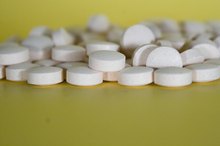Adderall is the brand name of a prescription drug used to treat attention-deficit/hyperactivity disorder and a sleep disorder called narcolepsy 23. Adderall is a stimulant drug. There are several drugs similar to Adderall, which are also stimulants but there are important differences. These include methylphenidate, amphetamine, dextroamphetamine and methamphetamine. Adderall and similar drugs should only be used as directed and recommended by your doctor.
If you are experiencing serious medical symptoms, seek emergency treatment immediately.
Attention-Deficit/Hyperactivity Disorder
ADHD affects children and adults. Five out of every 100 children are estimated to have ADHD. Clinical evidence strongly supports the use of stimulant drugs for ADHD, along with behavioral therapy 1. Stimulant drugs provide benefit during the day, but interfere with sleep at night. One main difference among different brands of stimulant drugs is their duration of action. A single dose of shorter-acting brands is effective for 3 to 5 hours; intermediate-acting for 4 to 8 hours; and longer-acting brands work for 8 to 12 hours. Taking an afternoon dose of a short-acting drug while at school can be problematic for some children. So, longer-acting stimulant drugs may be preferred over shorter-acting ones.
- ADHD affects children and adults.
- Taking an afternoon dose of a short-acting drug while at school can be problematic for some children.
Methylphenidate
Differences Between Strattera & Concerta
Learn More
Methylphenidate is the most widely used stimulant drug for ADHD. Methylphenidate, dextroamphetamine and amphetamine are all effective and can be substituted for each other if one of them does not work well for a particular patient. Methylphenidate is available in shorter-acting forms, such as Ritalin, Methylin and Focalin. Intermediate-acting forms include Ritalin SR, Methylin ER and Metadate ER. Longer-acting brands include Concerta, Metadate CD, Ritalin LA and Focalin XR.
Methylphenidate is also available as a skin patch sold under the brand name Daytrana. This is a longer-acting form of the drug. The advantage of the patch is that it can be taken off early if there are sleep problems.
- Methylphenidate is the most widely used stimulant drug for ADHD.
Amphetamine and Dextroamphetamine
Dextroamphetamine (Dexedrine, Dexedrine Spansules) is another effective stimulant drug used for ADHD. The Dexedrine brand is shorter-acting and Dexedrine Spansules are longer-acting. Adderall, which is a mixture of amphetamine and dextroamphetamine, is as effective as other stimulant drugs. Adderall is shorter-acting while the extended release Adderall XR is longer-acting.
Lisdexamfetamine (Vyvanse) is an inactive form of dextroamphetamine. After taking the tablet, it is converted into the active drug dextroamphetamine within the body. The advantage of lisdexamfetamine is that side effects may be less due to gradual conversion into the active drug. Methamphetamine hydrochloride (Desoxyn, Desoxyn Gradumet) is another stimulant drug, which can be prescribed to treat ADHD if other stimulant medications are not effective.
- Dextroamphetamine (Dexedrine, Dexedrine Spansules) is another effective stimulant drug used for ADHD.
- Methamphetamine hydrochloride (Desoxyn, Desoxyn Gradumet) is another stimulant drug, which can be prescribed to treat ADHD if other stimulant medications are not effective.
Nonstimulant Drugs for ADHD
Differences Between Strattera & Concerta
Learn More
Atomoxetine (Strattera) is a nonstimulant drug, which may be prescribed to children with ADHD who do not respond well to stimulant drugs or have intolerable side effects. Atomoxetine does not interfere with sleep like stimulant drugs.
Side Effects and Precautions
Common side effects of stimulant drugs include:
- loss of appetite
- weight loss
- sleep disturbances
- headaches
- irritability
- nausea
Tell your doctor if you have high blood pressure or heart problems before taking any stimulant medication.
Related Articles
References
- The Medical Letter; Drugs for Treatment of ADHD
- Pediatrics: Evidence Treatment of Attention-Deficit/Hyperactivity Disorder: Overview of the Evidence
- Journal of Psychopharmacology: Systematic Review of National and International Guidelines on Attention-Deficit Hyperactivity Disorder
- Wolraich M, Brown L, Brown RT, et al. ADHD: Clinical practice guideline for the diagnosis, evaluation, and treatment of attention-deficit/hyperactivity disorder in children and adolescents. Pediatrics. 2011;128(5):1007-22.
- American Academy of Pediatrics. ADHD: Clinical practice guideline for the diagnosis, evaluation, and treatment of attention-deficit/hyperactivity disorder in children and adolescents. Pediatrics. 2011;128(5):1007-1022. doi:10.1542/peds.2011-2654
- Briars L, Todd T. A review of pharmacological management of attention-deficit/hyperactivity disorder. J Pediatr Pharmacol Ther. 2016;21(3):192-206.
- Spencer TJ, Brown A, Seidman LJ, et al. Effect of psychostimulants on brain structure and function in ADHD: a qualitative literature review of magnetic resonance imaging-based neuroimaging studies. J Clin Psychiatry. 2013;74(9):902-17.
Writer Bio
Kaushik Desai is a research scientist and professor of pharmacology at a university in Canada. He has been doing research on diabetes and hypertension for more than 10 years. He has published several research articles in peer-reviewed, top-rated scientific journals such as "Nature" and "Diabetes".








